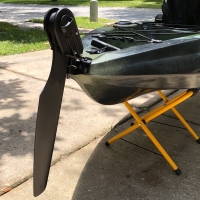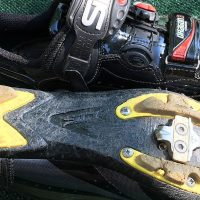Subscribe to my channel:
Charger/Converter Upgrade
Upgrading my Travel Trailer for Lithium
I bought my Forest River IBEX 23RLDS under the impression that it a was "Lithium Ready" travel trailer. While the Solar Side of things was Lithium Ready, the onboard Charger/Converter (Distribution Center), the system that manages the 120v coming into the trailer, was not.
The Power Distribution Center in my IBEX was a WF-8955PEC and is NOT Lithium Battery Compatible. The WF-8955PEC's charging system is designed explicitly for lead-acid (Flooded/AGM) batteries. The WF-8955LiS is the model that was supposed to be installed for the IBEX to be "Lithium Ready."
The WF-8955LiS has a switch option, allowing one to change charging modes between lead-acid and lithium batteries by simply sliding a switch in one direction or the other.
The short version (confirmed by Forest River's Engineer):
- The PEC will not fully charge Lithium batteries; he stated "95% or so." We all know that a Lead-Acid algorithm will only get the LiPo to 70-80% in most cases.
- The PEC is not going to properly Float the battery (as stated, "it's close").
- The PEC will not output the required 14.6v for "Fast Bulk" charging of Lithium. The Lead-Acid algorithm does not have a Fast Charge state.
- Lithium Battery warranties don't cover improper charging. Many specifically state that a "Lithium Charger must be used."
The PEC is designed and sold as a Lead-Acid Charger, and by that definition alone, disqualifies the PEC as a Lithium Ready Charger and disqualifies the IBEX 23RLDS as a Lithium Ready Travel Trailer. While the PEC may safely "charge" Lithium batteries (somewhat), as stated on WFCO's website, the PEC is not designed for Lithium Charging and by Forest River's own engineer's statements, does present quite a few shortcomings for Lithium use.
The Nuts & Bolts:
A 12v lithium LiFePO4 battery fully charged to 100% will hold voltage around 13.3-13.4v. A lead-acid battery will be around 12.6-12.7v. A lithium battery at 20% capacity will hold voltage around 13V; lead-acid will be around 11.8v at the same capacity.
A Lithium LiFePO4 charger is a voltage-limiting device that has similarities to the lead-acid system. The differences with Li-ion relate to the higher voltage per cell, tighter voltage tolerances, and the absence of trickle or float charge at full charge. While lead-acid offers some flexibility in terms of voltage cut-off, manufacturers of LiFePO4 cells are stringent on the correct setting because Li-ion cannot accept overcharge.
Lithium chargers are based on a CV/CC (constant voltage/constant current) charge algorithm. The charger limits the amount of current to a pre-set level until the battery reaches a pre-set voltage level. The current then reduces as the battery becomes fully charged. This system allows fast charging without the risk of over-charging and is required for all Li-ion batteries.
Most, if not all, lead-acid chargers have an equalization mode. On most chargers, this mode is automatic and can't be turned off. Lithium batteries do not require any form of equalization. Applying an equalization charge of 15v+ to a lithium battery will damage the cells beyond repair.
The other function that lead-acid chargers have is a "return to bulk" voltage. A 100% full lead-acid battery's voltage is approx 12.7v. Once the charger is in Float mode, it will maintain the battery at a pre-set voltage (normally between 13.3-13.8v subject to the battery type) and supports any loads running at the time. If the loads increase past the charger's maximum output in Float, then the battery voltage will start to reduce. Once the voltage reaches the "return to bulk" voltage, the charger will begin a new charge cycle and re-charge the battery at Bulk Voltage rates.
The "return to bulk" voltage setting in lead-acid chargers is normally 12.5-12.7v. This voltage for a lithium battery is way too low. At this voltage, the lithium battery will have been depleted to approx 10-15% state of charge. Lithium charge algorithms will normally set a return to Bulk voltage of 13.1-13.2V. Just another reason that a standard lead-acid charger doesn't work for lithium batteries.
Most lead-acid chargers "ping" the battery on startup to determine the voltage/resistance of the battery. Based on return information, the charger then determines what charge phase to start in. Because Lithium will hold voltage above 13+v, these lead-acid chargers will see this as a nearly full battery and enter into a Float stage and bypass the charge stage altogether.











We recently purchased a 2019 Grand Design 28 MKS, with 1- 12v battery.
I would like to add another battery and hookup in parallel. Is it pretty straight forward?
Do you know of a youtube site?
Thanks
Yes, the key is to keep the batteries the same kind, brand, Ah, and as close in age as possible. I had a dial Lead-Acid Setup before Lithium.
We purchased a 2021 Grand Design 303RLS and want to remove the single lead acid battery and upgrade to a lithium 206 Ah battery. What is your best guess, will I need to replace the OEM converter or can i plug and play? What charging specs. would I look for on the OEM converter to verify a lithium battery compatibility?
Thx,
In the process of doing the exact same. I just got my new 8955LIS MBA yesterday. Amazon sells them independently now. All looks relatively straight forward. Take pictures and label. Have to hold off a bit on getting the lithium batteries. Gotta build up the cash reserves. lol. Thanks for the in depth video and explanation. Heard some people were having issues with the Auto Detect version. Like the switch better.